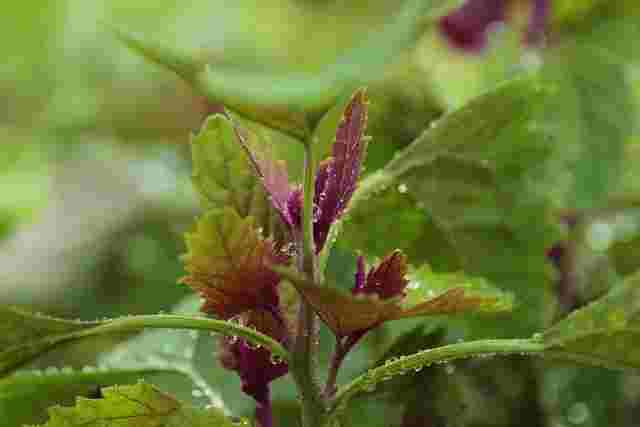Introduction:
In the vast realm of plant diversity, the family Chenopodiaceae, commonly known as the goosefoot family, houses an array of leafy greens that have contributed to human diets for centuries. Among these nutritional powerhouses is the White Goosefoot, scientifically known as Chenopodium album. In this comprehensive exploration, we will delve into the characteristics of White Goosefoot, its nutrient profile, its historical and cultural significance, and its potential impact on modern diets.
White Goosefoot (Chenopodium album):
White Goosefoot, often referred to simply as goosefoot, is an annual herbaceous plant that belongs to the genus Chenopodium. Known for its distinctive, toothed leaves that somewhat resemble a goose’s foot, this plant has a wide distribution across various continents, thriving in diverse climates. While it is often considered a weed in some regions, its nutritional value and historical use in traditional medicine have elevated its status in the culinary world.
Nutrient Profile of White Goosefoot:
White Goosefoot is a nutritional powerhouse, rich in essential nutrients that contribute to overall health and well-being. Understanding its nutrient profile is crucial for those seeking to incorporate it into their diets. Some key nutrients found in White Goosefoot include:
- Vitamins: White Goosefoot is a good source of vitamins, particularly vitamin A, which is essential for vision, immune function, and skin health. It also contains vitamin C, an antioxidant that supports immune function and helps the body absorb iron.
- Minerals: The plant is rich in minerals such as calcium, iron, magnesium, and potassium. Calcium is crucial for bone health, iron for oxygen transport, magnesium for muscle and nerve function, and potassium for maintaining proper fluid balance.
- Protein: White Goosefoot is a notable plant-based protein source, making it a valuable addition to vegetarian and vegan diets. Protein is fundamental for building and fixing tissues, supporting safe capability, and keeping up with bulk.
- Dietary Fiber: With a high content of dietary fiber, White Goosefoot contributes to digestive health by promoting regular bowel movements, preventing constipation, and supporting a healthy gut microbiome.
- Phytochemicals: The plant contains various phytochemicals, including flavonoids and polyphenols, which have antioxidant properties. These mixtures assist with safeguarding cells from oxidative pressure and aggravation.
Historical and Cultural Significance:
White Goosefoot has a rich history intertwined with human civilizations. Indigenous communities and traditional cultures recognized the plant’s value as a food source and for its medicinal properties. In some regions, White Goosefoot was cultivated and consumed as a staple, providing sustenance during challenging times. The plant’s adaptability and ability to thrive in diverse environments made it a valuable resource for communities across the globe.
Goosefoots in Traditional Diets:
Various species of goosefoot, including White Goosefoot, have been integral to traditional diets in different parts of the world. In regions such as India, the leaves are used in dishes like “bathua ki sabzi,” a curry made with White Goosefoot leaves and spices. In Mediterranean cuisine, the plant is used in salads, pies, and as a filling for traditional dishes. Its versatility in culinary applications reflects its historical importance as a nutrient-dense food source.
Culinary Uses and Recipes:
White Goosefoot’s mild flavor and tender leaves make it a versatile ingredient in the kitchen. Incorporating it into your diet can be a delightful and nutritious experience. Here are a couple of recipes to showcase the culinary potential of White Goosefoot:
White Goosefoot and Potato Gratin:
Ingredients: White Goosefoot leaves, potatoes, grated Parmesan cheese, olive oil, garlic, salt, and pepper. Instructions: Preheat oven to 375°F (190°C). Sauté minced garlic in olive oil. Add chopped White Goosefoot leaves and cook until wilted. Layer thinly sliced potatoes and cooked White Goosefoot mixture in a baking dish. Sprinkle Parmesan cheese, salt, and pepper between layers. Continue layering, finishing with a layer of cheese on top. Bake for 40-45 minutes until potatoes are tender and top is golden brown. Serve as a side dish or light main course.
-
White Goosefoot and Chickpea Salad:
– Ingredients:
– White Goosefoot leaves, washed and chopped
– Cooked chickpeas
– Cherry tomatoes, halved
– Cucumber, diced
– Red onion, finely chopped
– Feta cheese, crumbled
– Olive oil
– Lemon juice
– Fresh herbs (such as parsley or mint)
– Salt and pepper to taste
– Instructions:
1. In a large bowl, combine chopped White Goosefoot leaves, cooked chickpeas, cherry tomatoes, cucumber, and red onion.
2. In a separate small bowl, whisk together olive oil, lemon juice, salt, and pepper to create the dressing.
3. Shower the dressing over the serving of mixed greens and throw tenderly to consolidate.
4. Sprinkle crumbled feta cheese and fresh herbs over the top.
5. Serve chilled as a refreshing salad.
-
Modern Research and Health Implications:
Contemporary scientific research has started to shed light on the health implications of incorporating White Goosefoot into modern diets. Studies suggest that the plant’s nutritional composition, including its antioxidant content, may contribute to overall health and wellness. The potential benefits may include:
- Anti-Inflammatory Properties: Some studies indicate that the phytochemicals present in White Goosefoot may have anti-inflammatory effects, which could be beneficial in reducing inflammation in the body.
- Antioxidant Support:** The antioxidant compounds in White Goosefoot may play a role in neutralizing free radicals, thus helping to protect cells from oxidative stress and potentially reducing the risk of chronic diseases.
- Cardiometabolic Health:** The mineral content, particularly potassium and magnesium, may contribute to cardiovascular health by regulating blood pressure and supporting overall heart function.
- Digestive Health: The high dietary fiber content of White Goosefoot may support digestive health by promoting regular bowel movements and fostering a healthy gut microbiome.
-
Challenges and Considerations:
While White Goosefoot offers a range of nutritional benefits, it’s important to consider certain factors before incorporating it into your diet. Some considerations include:
- Wild vs. Cultivated Varieties: When foraging for White Goosefoot in the wild, it’s crucial to accurately identify the plant and ensure that it is free from contaminants. Cultivated varieties purchased from reputable sources are a safer alternative.
- Potential Allergies: Individuals with known allergies to plants in the Amaranthaceae family, to which goosefoots belong, should exercise caution and consult with a healthcare professional before including White Goosefoot in their diets.
- Preparation Methods:Proper washing and cooking are essential to remove any potential contaminants and enhance digestibility. Cooking methods such as blanching or sautéing are recommended to ensure the plant is safe for consumption.
-
Conclusion: A Nutrient-Rich Addition to Modern Diets:
White Goosefoot, with its rich nutrient profile and historical significance, offers a unique opportunity to diversify and enrich modern diets. As we rediscover traditional foods and explore the potential of lesser-known greens, incorporating White Goosefoot into our culinary repertoire provides a gateway to both flavor and nutrition. From its historical role in traditional cuisines to its potential health benefits supported by modern research, this humble plant invites us to embrace the wealth of nutrients it offers, contributing to a more varied, balanced, and nourishing approach to diet and well-being.



Average Rating